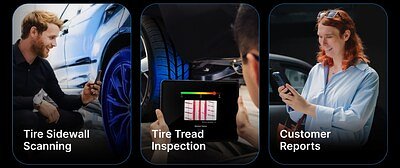
AI Drives Trust & Efficiency: Anyline's TireBuddy Redefines Vehicle Inspections
Anyline's AI-powered TireBuddy app isn't just streamlining tire inspections – it’s rebuilding trust with customers and setting a new standard for transparency in automotive maintenance. A look at the tech driving this change.
AI Drives Trust & Efficiency: Anyline's TireBuddy Redefines Vehicle Inspections
Vienna, Austria – November 6, 2025 – At SEMA 2025, the automotive aftermarket’s premier innovation showcase, Anyline unveiled significant upgrades to its TireBuddy app, signaling a broader shift towards AI-powered transparency and efficiency in vehicle maintenance. More than just a diagnostic tool, TireBuddy is aiming to rebuild trust between technicians and customers by leveraging artificial intelligence to deliver objective, data-driven insights.
Anyline, an Austrian AI company specializing in mobile data capture, has been steadily gaining traction in the automotive sector. Their TireBuddy app, now bolstered by a new AI assistant, improved scan guidance, and odometer integration, is quickly becoming a standout example of how technology is reshaping the automotive service experience.
From Inspection to Insight: What’s New in TireBuddy
The core of the update lies in TireBuddy’s AI assistant, which automatically populates inspection notes with detailed tire condition assessments. This feature dramatically reduces the potential for subjective interpretations, providing a clear and consistent record of each tire’s condition. “The goal isn’t just to identify problems, but to communicate them clearly,” explained a source familiar with the development. “Customers want to understand why a repair is needed, and data-driven explanations build confidence.”
Beyond the AI assistant, Anyline has refined the app's scanning capabilities, ensuring more accurate and reliable data capture. The integrated odometer reading adds another layer of context, allowing technicians to track tire wear over time and provide proactive maintenance recommendations. “This isn’t about upselling,” said one industry observer at SEMA. “It’s about offering a more comprehensive service and building long-term customer relationships.”
Rebuilding Trust in a Traditionally Opaque Industry
For years, automotive repair has been plagued by a lack of transparency. Customers often feel at a disadvantage, unsure whether recommended repairs are truly necessary or simply a means to increase profits. “There’s a historical disconnect,” noted a technician speaking on background. “Customers often don’t understand the technical jargon, and that creates mistrust.”
Anyline’s approach directly addresses this issue by prioritizing clear communication and data-driven insights. The app’s objective assessments, combined with detailed explanations, empower customers to make informed decisions about their vehicle’s maintenance. “The AI doesn’t replace the technician’s expertise,” clarified another source. “It enhances it, providing a powerful tool for clear and effective communication.”
Beyond Tires: The Broader Trend of AI in Automotive Maintenance
TireBuddy’s success isn’t an isolated incident. Across the automotive aftermarket, AI is rapidly gaining traction, transforming everything from diagnostics to parts ordering. Topdon and Launch Tech, key competitors in the space, are also integrating AI into their diagnostic tools, offering similar features and benefits.
“We’re seeing a shift from reactive maintenance to proactive prevention,” said an industry analyst at SEMA. “AI allows technicians to identify potential problems before they become major issues, saving customers time and money.”
This trend is fueled by several factors, including the increasing complexity of modern vehicles and the growing demand for personalized service. Customers are no longer satisfied with simply fixing what’s broken; they want a holistic approach to vehicle maintenance that addresses their individual needs and preferences.
Challenges and Opportunities Ahead
Despite the potential benefits, the widespread adoption of AI in automotive maintenance isn’t without its challenges. Data privacy and security are major concerns, as is the need for ongoing training and education to ensure technicians can effectively utilize these new technologies.
“There’s a learning curve,” admitted a technician who recently implemented TireBuddy in his shop. “But the benefits far outweigh the challenges. It’s making my job easier, and it’s allowing me to provide a better service to my customers.”
Looking ahead, Anyline plans to expand the capabilities of TireBuddy, incorporating additional diagnostic features and integrating with other automotive service platforms. They are also exploring the use of machine learning to predict tire wear and identify potential safety hazards.
“We believe AI has the power to transform the automotive industry,” said a company spokesperson. “Our goal is to create a more transparent, efficient, and customer-centric experience for everyone.”
The rise of AI-powered tools like TireBuddy signifies a broader shift in the automotive landscape. It’s a move towards a future where transparency, data-driven insights, and customer trust are paramount—a future where the relationship between technician and customer is built on a foundation of mutual understanding and confidence.
📝 This article is still being updated
Are you a relevant expert who could contribute your opinion or insights to this article? We'd love to hear from you. We will give you full credit for your contribution.
Contribute Your Expertise →